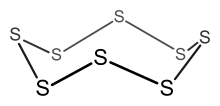Cyclic compounds

Chemical compounds are called cyclic compounds if at least some of the atoms in the molecule that make them up are linked together in such a way that one or more rings are formed. Cyclic structures mainly occur in carbon-containing organic compounds , but they can also occur in inorganic compounds . If large rings are formed with a high number of atoms involved, one speaks of macrocyclic compounds . In contrast to this, acyclic compounds have an exclusively chain-like structure.
Ring-shaped compounds can be produced by suitable cyclization reactions ( ring closure reactions).
Homocyclic and heterocyclic compounds


In homo- or isocyclic compounds , the ring consists only of atoms of the same element. A classic example of an inorganic homocyclic compound is λ- sulfur , which forms crown-shaped rings made up of 8 sulfur atoms.
Compounds whose ring-forming atoms are exclusively carbon atoms are called carbocyclic compounds (carbocycles). The simplest compound in this class is cyclopropane C 3 H 6 , which belongs to the cycloalkanes . Further examples of carbocyclic molecules are: Cyclohexane , which is required for nylon production, naphthalene , which was previously used in mothballs and benzene , which increases the knock resistance of gasoline.
If a heteroatom is contained in at least one ring of the entire molecule , it is referred to as a heterocyclic compound . Heterocycles play an important role in biological processes. Everyday examples of this are caffeine and nicotine . However, heterocycles also occur in DNA and color and odor substances . Inorganic heterocycles include metaphosphates , metasilicic acids, and borazine .
Nomenclature according to the number of rings
-
Monocyclic compounds or monocycles are cyclic compounds that contain only a single ring. They are designated with the prefix Cyclo- in chemical nomenclature . Examples are cyclohexane or cyclooctatetraene . Often, however , aromatic or heterocyclic compounds are given proper names such as benzene or melamine .
-
Polycyclic compounds or polycycles are compounds that consist of several rings. Their nomenclature is very complicated and depends on the way the rings are linked.
Examples: anthracene , phenanthrene , pyrene- For polycycles that consist of two rings, the designation bicyclic or bicyclic compound is also common.
Examples: decalin, naphthalene - If several rings are linked to two bridgehead atoms , one speaks of bridged bicyclic compounds .
Example: norbornane - Two directly adjacent rings with a common bond are also referred to as a condensed or fused ring system.
- For polycycles that consist of two rings, the designation bicyclic or bicyclic compound is also common.
Functional group nomenclature
Cyclic esters are called lactones . Cyclic amides form the lactams . Cyclic sulfonic acid amides are called sultams . Lactols are cyclic hemiacetals or hemiketal .
Aromatics (or arenes) form a cyclic structural motif from conjugated double bonds, which have a particular stability. If they have several aromatic ring structures, they are divided into the group of polycyclic aromatic hydrocarbons (PAH). Alicyclic compounds are ring-shaped hydrocarbons that do not meet the aromaticity criteria.
Spiro compounds are polycyclic organic compounds whose rings are only connected to one atom. Catenanes contain at least two rings intertwined in a chain, rotaxanes contain a ring that is penetrated by a dumbbell-shaped molecule.
Examples of monocycles according to the number of ring atoms
In laboratory jargon , a "three-ring", "four-ring" etc. is often used. A statement is made here about the number of ring atoms, but not about the type of atoms (for example carbon or heteroatoms) or the functional groups forming the ring.
- Three ring
- Four-ring
- Cyclobutane , β- lactams , β- lactones
- Five-membered ring
- Six-ring
- Benzene , cyclohexane , phenol , piperidine , pyran , pyranoses , pyridine , sulfur ( cyclohexasulfur )
- Seven-ring
- Caprolactam , caprolactone , cycloheptane , diazepines , sulfur ( cycloheptasulfur ), tropolones
- Eight ring
- Cyclooctane , octogen , sulfur ( cyclooctasulfur )
Individual evidence
- ↑ Entry on homocyclic compounds . In: IUPAC Compendium of Chemical Terminology (the “Gold Book”) . doi : 10.1351 / goldbook.H02843 Version: 2.1.5.
- ↑ Entry on isocyclic compounds . In: IUPAC Compendium of Chemical Terminology (the “Gold Book”) . doi : 10.1351 / goldbook.I03271 Version: 2.3.3.
- ↑ Entry on carbocyclic compounds . In: IUPAC Compendium of Chemical Terminology (the “Gold Book”) . doi : 10.1351 / goldbook.C00818 Version: 2.1.5.
- ↑ Entry on heterocyclic compounds . In: IUPAC Compendium of Chemical Terminology (the “Gold Book”) . doi : 10.1351 / goldbook.H02798 Version: 2.1.5.
